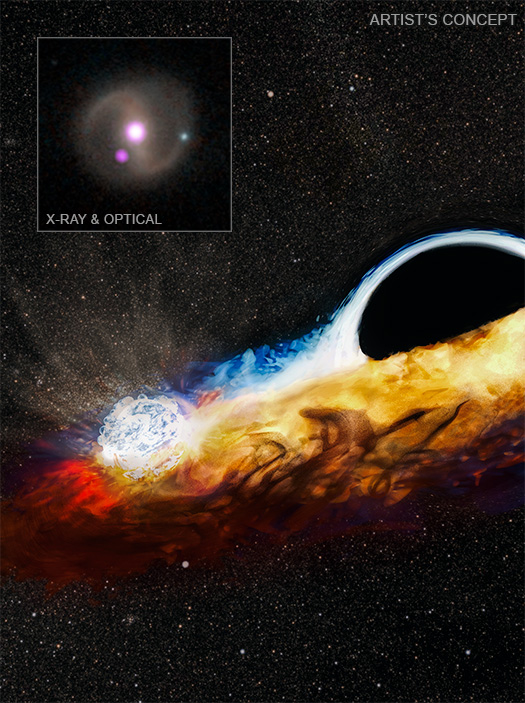News — A massive black hole has torn apart one star and is now using that stellar wreckage to pummel another star or smaller black hole that used to be in the clear.
This discovery, made with NASA’s Chandra X-ray Observatory, Hubble Space Telescope, NICER (Neutron Star Interior Composition Explorer), Neil Gehrels Swift Observatory, and other telescopes, helps astronomers link two mysteries where there had previously only been hints of a connection.
In 2019, astronomers witnessed the signal of a star that got too close to a black hole and was destroyed by the black hole’s gravitational forces. Once shredded, the star’s remains form a disk that circles around the black hole, like a type of stellar graveyard. Over a few years, however, this disk has expanded outward and is now directly in the path of another star, or possibly a stellar-mass black hole, orbiting the massive black hole at a previously safe distance. This orbiting star is now repeatedly crashing through the debris disk, about once every 48 hours, as it circles. When it does, the collision causes bursts of X-rays that astronomers captured with Chandra.
“Imagine a diver repeatedly going into a pool and creating a splash every time she enters the water,” said Matt Nicholl of Queen’s University Belfast, United Kingdom, the lead author of the study that appears in the current issue of Nature. “The star in this comparison is like the diver and the disk is the pool, and each time the star strikes the surface it creates a huge ‘splash’ of gas and X-rays. As the star orbits around the black hole, it does this over and over again.”
Scientists have documented many cases where an object gets too close to a black hole and gets torn apart in a single burst of light. Astronomers call these “tidal disruption events.” In recent years, astronomers have also discovered a new class of bright flashes from the centers of galaxies, which are detected only in X-rays and repeat many times. These events are also connected to supermassive black holes, but astronomers could not explain what caused the semi-regular bursts of X-rays. They dubbed these “quasi-periodic eruptions.”
“There had been feverish speculation that these phenomena were connected, and now we’ve discovered the proof that they are,” said co-author Dheeraj Pasham of the Massachusetts Institute of Technology. “It’s like getting a cosmic two-for-one in terms of solving mysteries.”
This tidal disruption event now known as AT2019qiz was first discovered by a wide-field optical telescope at the Palomar Observatory, called the Zwicky Transient Facility, in 2019. In 2023, astronomers used both Chandra and Hubble to study the debris left behind after the tidal disruption had ended. The Chandra data was obtained during three different observations, each separated by about 4 to 5 hours. The total exposure of about 14 hours of Chandra time revealed only a weak signal in the first and last chunk, but a very strong signal in the middle observation. From there Nicholl and his colleagues used NICER to look frequently at AT2019qiz for repeated X-ray bursts. The NICER data showed that AT2019qiz erupts roughly every 48 hours. Observations from Swift and India’s AstroSat telescope cemented the finding.
The ultraviolet data from Hubble, obtained at the same time as the Chandra observations, allowed the scientists to determine the size of the disk around the supermassive black hole. They found that the disk had become large enough that if any object was orbiting the black hole with a period of about a week or less, it would collide with the disk and cause eruptions.
“This is a big breakthrough in our understanding of the origin of these regular eruptions,” said Andrew Mummery of Oxford University. “We now realize we need to wait a few years for the eruptions to ‘turn on’ after a star has been torn apart because it takes some time for the disk to spread out far enough to encounter another star.”
This result has implications for searching for more quasi-periodic eruptions associated with tidal disruptions. Finding more of these would allow astronomers to measure the prevalence and distances of objects in close orbits around supermassive black holes. Some of these may be excellent targets for the planned future gravitational wave observatories. NASA’s missions are part of a growing, worldwide network of missions with different but complementary capabilities, watching for changes like these to solve mysteries of how the universe works.
The paper describing these results was first published online by Nature on Oct. 9, 2024. It will appear in print in the October 24 issue of the journal. NASA's Marshall Space Flight Center in Huntsville, Alabama, manages the Chandra program. The Smithsonian Astrophysical Observatory's Chandra X-ray Center controls science operations from Cambridge, Massachusetts, and flight operations from Burlington, Massachusetts.
Media Contacts:
Megan Watzke

Chandra X-ray Center
Cambridge, Mass.

617-496-7998
Lane Figueroa

Marshall Space Flight Center, Huntsville, Alabama

256-544-0034



